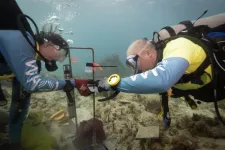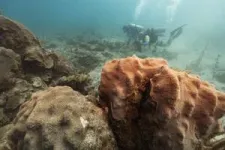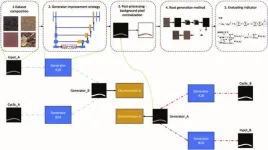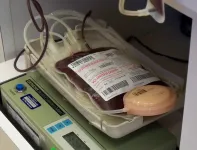(Press-News.org) Woods Hole, Mass. – A healthy coral reef is noisy, full of the croaks, purrs, and grunts of various fishes and the crackling of snapping shrimp. Research suggests that larval animals use this symphony of sounds to help them determine where they should live and grow.
Researchers at the Woods Hole Oceanographic Institution (WHOI) recently demonstrated that replaying healthy reef sounds could potentially be used to encourage coral larvae to recolonize damaged or degraded reefs. A reef that has been degraded – whether by coral bleaching, disease, or direct human impacts – can’t support the same diversity of species and has a much quieter, less rich soundscape. In a paper published on Wednesday, March 13, in Royal Society Open Science, the researchers showed that broadcasting the soundscape of a healthy reef at a degraded reef caused coral larvae to settle at significantly higher rates.
“What we’re showing is that you can actively induce coral settlement by playing sounds,” said Nadège Aoki, a doctoral candidate at WHOI and first author on the paper. “You can go to a reef that is degraded in some way and add in the sounds of biological activity from a healthy reef, potentially helping this really important step in the coral life cycle.”
Corals are immobile as adults, so the larval stage is their only opportunity to select a good habitat. They swim or drift with the currents, seeking the right conditions to settle out of the water column and affix themselves to the seabed. Previous research has shown that chemical and light cues can influence that decision, but Aoki and her colleagues demonstrate that the soundscape also plays a major role in where corals settle.
The researchers conducted their work in the U.S. Virgin Islands, running the same experiment twice in June and July 2022. They collected larvae from Porites astreoides, a hardy species commonly known as mustard hill coral thanks to its lumpy shape and yellow color and distributed them in cups at three reefs along the southern coast of St. John. One of those reefs, Tektite, is relatively healthy. The other two, Cocoloba and Salt Pond, are more degraded with sparse coral cover and fewer fish. At Salt Pond, Aoki and her colleagues installed an underwater speaker system and placed cups of larvae at distances of one, five, 10, and 30 meters from the speakers. They broadcast healthy reef sounds – recorded at Tektite in 2013 – for three nights. They set up similar installations at the other two reefs but didn’t play any sounds.
When they collected the cups, the researchers found that significantly more coral larvae had settled in the cups at Salt Pond than the other two reefs. On average, coral larvae settled at rates 1.7 times (and up to 7x) higher with the enriched sound environment. The highest settlement rates were at five meters from the speakers, but even the cups placed 30 meters away had more larvae settling to the bottom than at Cocoloba and Tektite.
“The fact that settlement is consistently decreasing with distance from the speaker, when all else is kept constant, is particularly important because it shows that these changes are due to the added sound and not other factors,” said Aran Mooney, a marine biologist at WHOI and lead author on the paper. “This gives us a new tool in the toolbox for potentially rebuilding a reef.”
Surprisingly, the researchers didn’t find much difference between settlement rates at the more-degraded Cocoloba and the healthier Tektite reefs. A previous study in 2017 had found higher settlement rates at Tektite than Cocoloba. Some of this could be attributed to natural variation, Mooney said, but the Tektite reef has also faced several destructive hurricanes, a significant bleaching event, and an outbreak of coral disease in recent years.
“We seem to have lost some of the complexity of Tektite’s soundscape over the last decade,” Aoki said. “It could be that conditions there are not as good as we thought they were, but we don’t know for sure.”
The possible drop-in settlement rates at Tektite underscores the severity of the threats that coral reefs are facing and the need for rapid, scalable solutions, the researchers said. Coral reefs support more than a quarter of all marine animals, protect coastlines from strong waves and storms, and provide food and tourism opportunities for millions of people around the world. But researchers estimate that half of all coral reefs have been lost in the last 30 years.
Aoki, Mooney, and their colleagues hope that their work can help with coral restoration efforts. Enhanced soundscapes could be used to increase settlement rates in coral nurseries, for example, or be passively broadcast at reefs in the wild to maintain or improve existing coral populations. People would still need to monitor reef conditions to ensure that coral larvae are able to thrive after they settle, but this is a significant step in the restoration process, and one that would be relatively simple to implement.
“Replicating an acoustic environment is actually quite easy compared to replicating the reef chemical and microbial cues which also play a role in where corals choose to settle,” said Amy Apprill, a microbial ecologist at WHOI and a co-author on the paper. “It appears to be one of the most scalable tools that can be applied to rebuild reefs, so we’re really excited about that potential.”
This research was supported by the Vere and Oceankind Foundations and the National Science Foundation.
END
Sonic youth: Healthy reef sounds increase coral settlement
New study confirms that larvae on degraded reefs can respond to healthy reef sounds
2024-03-13
ELSE PRESS RELEASES FROM THIS DATE:
Warwick awarded £11 million to train PhD students in computational modelling
2024-03-13
The University of Warwick has been awarded £11m to train PhD students in computational modelling.
The new centre will train 50 PhD students to use computational modelling to tackle pressing global sustainability challenges from accessing clean fusion energy, controlling infectious diseases, to designing energy-efficient devices such as new battery electrolytes.
The Centre for Doctoral Training in Modelling of Heterogeneous Systems (HetSys II), led by Professor James Kermode from the School of Engineering, Dr Livia Bartok-Partay from Chemistry and Professor Nicholas Hine from Physics, will train ...
Simple trick could improve accuracy of plant genetics research
2024-03-13
Researchers have published a simple trick that improves the accuracy of techniques that help us understand how external variables – such as temperature – affect gene activity in plants.
“There are really two contributions here,” says Colleen Doherty, corresponding author of a paper on the work and an associate professor of molecular and structural biochemistry at North Carolina State University. “First, we’re raising the visibility of a problem that many of us in the ...
Revolutionizing plant science: a groundbreaking method for expanding in situ root datasets using CycleGAN
2024-03-13
The root system is crucial for plants to absorb water and nutrients, with in situ root research providing insights into root phenotypes and dynamics. While deep-learning-based root segmentation methods have advanced the analysis of root systems, they require extensive manually labeled datasets, which are labor-intensive and time-consuming to produce. Current methods of in situ root observation vary in their effectiveness. Moreover, traditional root image recognition methods face challenges such as subjectivity and ...
COVID-19 rebound after VV116 vs nirmatrelvir-ritonavir treatment
2024-03-13
About The Study: In this randomized clinical trial of 345 patients with mild-to-moderate COVID-19, viral load rebound and symptom rebound were both common after a standard 5-day course of antiviral treatment with either VV116 or nirmatrelvir-ritonavir. Prolongation of treatment duration might be investigated to reduce COVID-19 rebound.
Authors: Yufang Bi, M.D., and Yiping Xu, M.Sc., of the Shanghai Jiao Tong University School of Medicine in Shanghai, China, are the corresponding authors.
To access the embargoed study: Visit our For ...
Mental well-being among adversity-exposed adolescents during the pandemic
2024-03-13
About The Study: The findings of this study of 4,515 adolescents suggest that in-person schooling and several coping behaviors (caring for one’s body, exercising, and engaging in healthy behaviors) were associated with significantly higher positive affect and lower perceived stress during the COVID-19 pandemic among adolescents with high adverse childhood experiences (ACEs). Adolescents with high ACEs demonstrated especially greater mental health scores when they reported in-person schooling. Future studies should build on these findings to identify clinical and school-based mental health protective ...
Enhancing plant photochemistry analysis: a novel approach to chlorophyll a fluorescence measurement under environmental stress
2024-03-13
Chlorophyll a fluorescence (ChlF) has been a pivotal tool in understanding plant photochemistry, offering insights into the energy transfer processes within chloroplasts and the efficiency of Photosystem II (PSII). Researchers have relied on quantifying ChlF through specific measures such as F0, Fm, and Fv under various lighting conditions to assess photosynthetic activities. Nonetheless, the technique encounters obstacles owing to the intrinsic uncertainties in gauging the absolute magnitude of ChlF and the fluctuation in baseline levels affected by environmental conditions. This complicates the interpretation of ...
It’s in the blood: donor diets can trigger allergic reactions in blood recipients
2024-03-13
Allergic transfusion reactions (ATRs), a potentially life-threatening side effect of blood transfusions with unclear mechanisms, may be linked to food allergies in pediatric patients as per a recent study by scientists from Japan. They found that ATRs may be triggered by the presence of allergens in the donor’s blood, influenced by their pre-donation diet. These findings could pave the way for safer blood transfusions through the development of preventive measures and countermeasures for ATRs.
Blood transfusions are often life-saving procedures in various medical settings. They are required not only after severe blood loss ...
Melissa A. Kelly, MS, CGC receives the 2024 ACMG Foundation Carolyn Mills Lovell Genetic Counselor Award
2024-03-13
Melissa A. Kelly, MS, CGC is the recipient of the 2024 ACMG Foundation Carolyn Mills Lovell Genetic Counselor Award. Ms. Kelly received the Lovell award for her platform presentation at the 2024 ACMG Annual Clinical Genetics Meeting, “Integrating genomic medicine into healthcare: Experience disclosing >5,000 clinically relevant results within the Geisinger MyCode Community Health Initiative.”
Ms. Kelly said, “Thank you to the ACMG Foundation. I am humbled and honored to receive the Carolyn Mills Lovell Genetic Counselor Award. Throughout my career, I have seen many ways in which patients and their families interact with and are impacted ...
Rory James Tinker, MD receives the 2024 Richard King Award for Best Publication by a Trainee in Genetics in Medicine
2024-03-13
Rory James Tinker, MD is the recipient of the 2024 Richard King Trainee Award. This award was instituted by the ACMG Foundation for Genetic and Genomic Medicine to encourage American Board of Medical Genetics and Genomics (ABMGG), international equivalents, or genetic counseling trainees in their careers and to foster the publication of the highest quality research in Genetics in Medicine (GIM), an official journal of the ACMG.
Each year the editorial board reviews all articles published in GIM by ...
ACMG Foundation/Revvity 2024 Travel Award presented to Meena Sethuraman, BS
2024-03-13
Meena Sethuraman, BS is the 2024 recipient of the ACMG Foundation/Revvity Travel Award. Ms. Sethuraman was selected to receive the award for her platform presentation, "Characterizing pathogenicity of ACADVL variants in very long-chain acyl-CoA dehydrogenase deficiency.”
Meena Sethuraman is a third-year medical student in the Physician Scientist Training Program at the University of Pittsburgh School of Medicine. Her research, being conducted with Dr. Jerry Vockley, FACMG, involves studying genetic variants in fatty acid oxidation disorders. Meena previously received her BS in Neurobiology at the University of Washington. Her undergraduate and post-baccalaureate ...
LAST 30 PRESS RELEASES:
Tracing the quick synthesis of an industrially important catalyst
New software sheds light on cancer’s hidden genetic networks
UT Health San Antonio awarded $3 million in CPRIT grants to bolster cancer research and prevention efforts in South Texas
Third symposium spotlights global challenge of new contaminants in China’s fight against pollution
From straw to soil harmony: International team reveals how biochar supercharges carbon-smart farming
Myeloma: How AI is redrawing the map of cancer care
Manhattan E. Charurat, Ph.D., MHS invested as the Homer and Martha Gudelsky Distinguished Professor in Medicine at the University of Maryland School of Medicine
Insilico Medicine’s Pharma.AI Q4 Winter Launch Recap: Revolutionizing drug discovery with cutting-edge AI innovations, accelerating the path to pharmaceutical superintelligence
Nanoplastics have diet-dependent impacts on digestive system health
Brain neuron death occurs throughout life and increases with age, a natural human protein drug may halt neuron death in Alzheimer’s disease
SPIE and CLP announce the recipients of the 2025 Advanced Photonics Young Innovator Award
Lessons from the Caldor Fire’s Christmas Valley ‘Miracle’
Ant societies rose by trading individual protection for collective power
Research reveals how ancient viral DNA shapes early embryonic development
A molecular gatekeeper that controls protein synthesis
New ‘cloaking device’ concept to shield sensitive tech from magnetic fields
Researchers show impact of mountain building and climate change on alpine biodiversity
Study models the transition from Neanderthals to modern humans in Europe
University of Phoenix College of Doctoral Studies releases white paper on AI-driven skilling to reduce burnout and restore worker autonomy
AIs fail at the game of visual “telephone”
The levers for a sustainable food system
Potential changes in US homelessness by ending federal support for housing first programs
Vulnerability of large language models to prompt injection when providing medical advice
Researchers develop new system for high-energy-density, long-life, multi-electron transfer bromine-based flow batteries
Ending federal support for housing first programs could increase U.S. homelessness by 5% in one year, new JAMA study finds
New research uncovers molecular ‘safety switch’ shielding cancers from immune attack
Bacteria resisting viral infection can still sink carbon to ocean floor
Younger biological age may increase depression risk in older women during COVID-19
Bharat Innovates 2026 National Basecamp Showcases India’s Most Promising Deep-Tech Ventures
Here’s what determines whether your income level rises or falls
[Press-News.org] Sonic youth: Healthy reef sounds increase coral settlementNew study confirms that larvae on degraded reefs can respond to healthy reef sounds





